Whitburn Spill Reduction (2017)
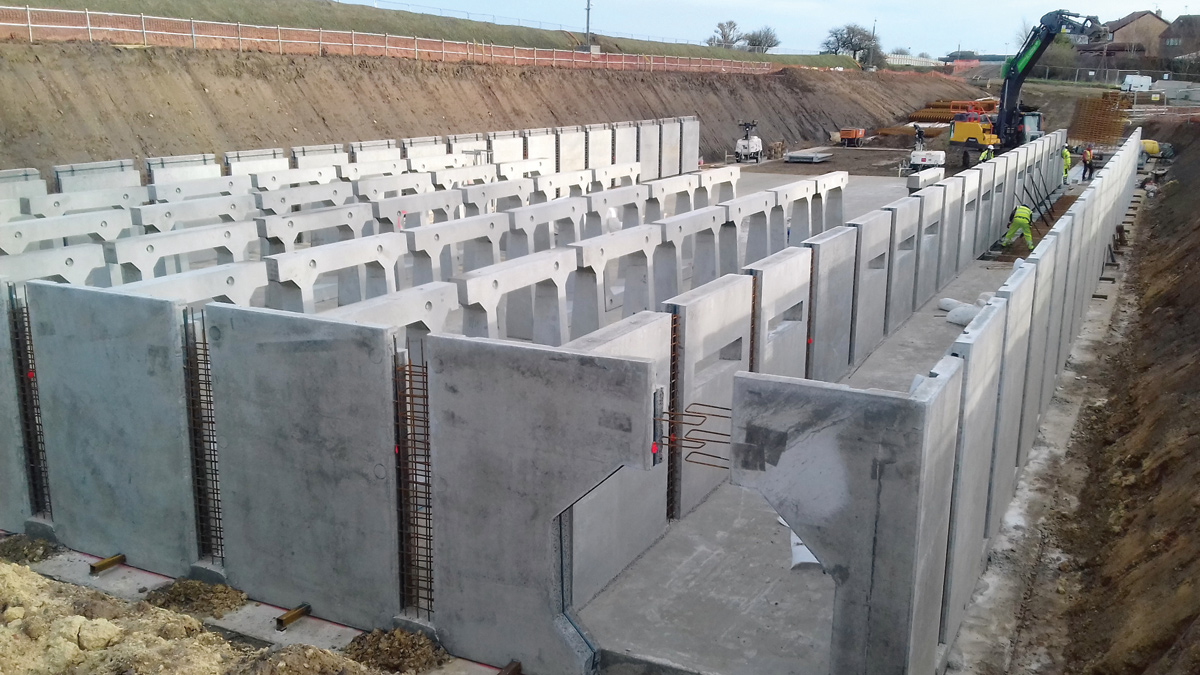
Precast units provide a fast and economic solution to creating large volumes of underground storage in Seaburn, Sunderland - Courtesy of ESH-MWH
Northumbrian Water is required to provide investment to reduce spills at Whitburn and St Peter’s, Sunderland in order to comply with the requirements of the Urban Waste Water Treatment Directive (UWWTD) by December 2017. Sunderland (north) is an urban catchment of predominantly residential properties and is home to Sunderland’s Blue Flag award winning beaches at Seaburn and Roker. The catchment is substantially combined and the beaches are presently protected by a storm interceptor tunnel which collects overflows from the combined sewer network during rainfall events.
Feasibility study
MWH (now Stantec UK) undertook a feasibility study in 2015 to identify options to achieve a spill frequency of 20 spills per annum at Whitburn and St Peter’s. The preferred option reduces discharges from the storm interceptor by optimising the operation of existing assets, providing storage near key pumping stations and reducing the amount of surface water that enters the sewer network using surface water separation and SuDS. Design & construction was by ESH-MWH, Northumbrian Water’s framework delivery partner, under an NEC option C contract. Construction works are due to complete September 2017.
Approach
The project team developed a thorough understanding of the network and operation of assets through careful review of measured data, discussions with operatives and interrogation of a verified hydraulic model.
An existing Infoworks ICM model was updated with information obtained from site surveys undertaken as part of this study. A short term flow survey was carried out and used to verify the model around the location of the key assets and at locations where surface water was to be removed and therefore confirm representation of the sewer system and its response to rainfall. Predicted operation of the tunnel was checked against historical telemetry records and radar rainfall. Annual spill frequency was assessed using 10 year Stormpac time series rainfall run as a continuous simulation to represent the impacts of filling and emptying of the storm interceptor.
The storm interceptor requires an additional 13,500m3 of storage and St Peter’s requires 3,000m3 of storage and associated infrastructure to achieve a spill frequency of 20 spills per annum. Large storage volumes present a problem for construction and operation; for example, having longer retention times, increased pumping and increased treatment costs. The approach taken by the project team to identify interventions was to:
- Maximise potential of existing assets.
- Take out surface water load on the combined sewer network.
- Use green infrastructure in conjunction with conventional drainage.
The feasibility study identified that there were opportunities to install smaller storage volumes further up in the catchment at the 3 main pumping stations, Seaburn, Roker and St Peter’s. Additionally, the study showed the storm tunnel does not completely fill during the spill events of concern and there is opportunity to install works to mobilise storage in the upper parts of the storm tunnel.
The catchment offers a number of opportunities for disconnecting surface water sewers and highway drainage from the combined sewer network, using conventional drainage or swales to redirect flow to a watercourse.
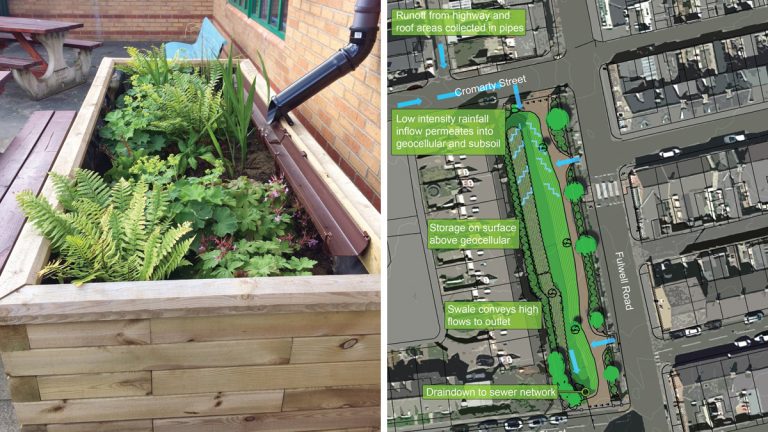
(left) A rainwater planter intercepting a rain water pipe at a school in Roker, Sunderland – Courtesy of Northumbrian Water and (right) Visualisation of a bioretention basin designed to attenuate and infiltrate in a residential area, Sunderland – Courtesy of ESH-MWH
Much of the catchment consists of dense housing served by fully combined sewers with no viable watercourse to divert surface water into. While full catchment separation is not considered viable, a portion of the roof and road area can be intercepted and attenuated in available green space and SuDS measures before return to the combined sewer network.
Measures such as bioretention swales make use of available green space to store water temporarily on the surface and encourage infiltration through the vegetation and into underlying soils.
Source control measures such as planters and rain gardens intercepting rain water pipes to reduce load on the combined sewer network are particularly well suited to addressing the ‘everyday’ rainfall that can lead to frequently spilling overflows.
This approach reduces the overall conventional storage volume requirement in the catchment to 4,700m3, a great efficiency compared to the original 16,500m3 requirement. In addition to reducing storage required, the solution provides additional benefits for:
- Increased sewer capacity, growth and flood risk reduction.
- Reduced pumping and treatment costs.
- Water quality, amenity and biodiversity enhancement from SuDS proposed.
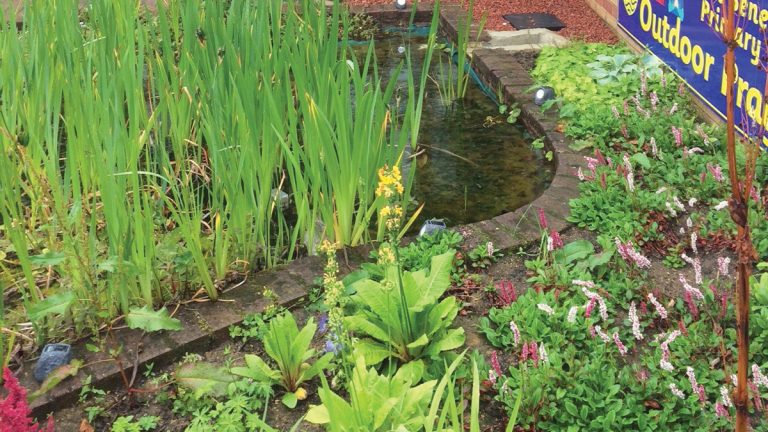
A raingarden planted in a small depression absorbs and temporarily stores rainwater in Roker, Sunderland – Courtesy of St Benet’s Primary School
Seaburn
A new 3,000m3 combined storage tank upstream of Seaburn Pumping Station reduces storm discharges to the interceptor tunnel. The tank has a gravity return and an Alpheus flow limiter controls pass forward flow to the pumping station.
A new surface water sewer and swale facilitates the removal of Boldon Flats Wetland, which drains into the combined sewer upstream of Seaburn Pumping Station. Regrading the outlet channel improves access to the outlet screen and planting a new reed bed provides water quality benefits.
Removal of Boldon Flats Wetland and the surrounding highway drainage and disconnection of surface water from a supermarket and surrounding development at Seaburn (which currently drains directly to the storm tunnel) all reduce storage volume requirements. The works comprised:
- 3m deep precast concrete storage tank designed and supplied by Carlow Concrete was constructed in battered excavation in farmland.
- Interconnecting pipework.
- Construction of 1,300m of DN375-450 pipework and swale across farmland at Boldon Flats.
- New screened inlet structure, regrading and planting including new reedbed within the Boldon Flats wetland.
- Construction of 260m of surface water pipework in highway and verge to pick up the supermarket and properties at Seaburn.
Roker
Roker Public Park, two schools and several public open spaces are benefitting from water features, planting and landscaping in return for space to store water. There is no viable watercourse in the dense residential area to divert surface water into and the solution uses surface water attenuation in SuDS features. These works reduce flow to the interceptor without the requirement for conventional storage.
Bioretention areas at Roker Public Park and two open green spaces within a residential area provide the majority of attenuation requirement. New surface water sewers carry surface water from local highway and roof drainage into the SuDS. They consist of an infiltration system formed by below ground geocellular storage, sized for 1 in 1 month storage, and a swale on the surface to convey excess flows. Landscaping and planting provide added amenity and biodiversity benefits. Bioretention areas drain back into the combined sewer system at a much reduced rate. The addition of water to Roker Park is a key feature for the regeneration of the park. These works were co-designed with Sunderland City Council and involved the ‘friends of the park’ community group, creating valuable buy-in and link to the community.
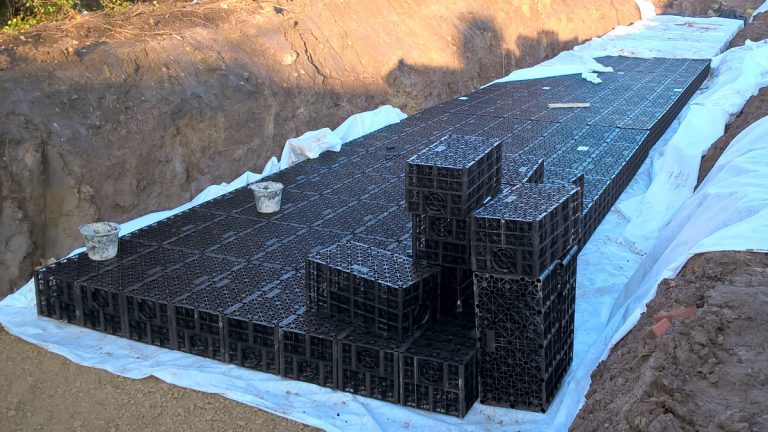
Installation of geocellular storage units for creating storage and encouraging infiltration at Redby site, Sunderland – Courtesy of ESH-MWH
A range of source control measures within schools, highway verge and near other large buildings provide the remaining attenuation. Rain gardens provide storage within permeable soils and surface depressions for capturing runoff from frequent rainfall events. Runoff from larger rainfall events overflows back to the combined sewer network. Suitable planting helps create attractive landscape features and increases biodiversity value. Rain gardens offer flexibility in shape and size. Roadside rain gardens intercept flow upstream of road gullies and attenuate in a permeable area replacing hard surfaced traffic calming measures. Runoff from larger rainfall events bypasses the rain garden and runs to the original gully.
Rainwater planters within schools provide amenity benefit and an educational opportunity for involving school children. Planters contain a planted soil mix and underdrain filter system. Lined timber boxes are positioned close to building roofs and intercept rainwater down pipes. They are designed to store a 1 in 1 month rainfall event and overflow back to the existing drainage system.
Self emptying water butts which ensure capacity is available during a rainfall event offer cheap solutions where space is limited. Works comprised:
- 1,800m of surface water sewer DN225-600 intercepting 100 gullies.
- Construction of 3 (No.) bioretention areas providing 1,300m3 attenuation.
- Construction of planters, rain gardens and roadside rain gardens intercepting 0.7ha of impermeable (road and roof) area.
St Peter’s
A new 1,700m3 storage tank on the overflow from St Peter’s CSO intercepts spills to the estuary. The tank returns flows to an existing pumping station on the quay. An actuated penstock operating off a level monitor controls draindown. The penstock is serviced from the existing pumping station power and telecoms. Surface water disconnection from the existing CSO spill reduces storage volume requirements. Works comprised:
- Precast storage tank constructed in an interlocking sheet piled cofferdam with concrete base plug located on the Wear estuary quayside.
- Interconnecting pipework.
- Mechanical and electrical installation for the actuated penstock.
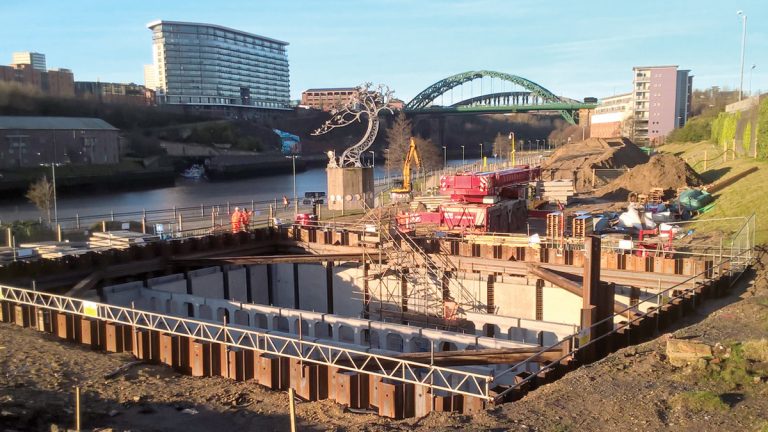
Precast units are lifted into place and tied together using in situ concrete strips at St Peter’s, Sunderland – Courtesy of ESH-MWH
Whitburn Spill Reduction – key participants
- Feasibility study: Stantec UK
- Design & build contractor: ESH-MWH
- Precast tank: Carlow Concrete
- Piling: McGrattan Piling
- Base plug design: Alan Auld
- Pipejacking: F & B Trenchless Solutions (IRE) Ltd
- M&E works: Retroflo
Construction
Construction of the project presented the team with a number of third party, environmental and customer challenges to overcome. The works were located at multiple sites across the catchment and within different land ownership. Successful implementation of the solution was driven by close working relationships with South Tyneside Council, Sunderland City Council, local schools, Sunderland University and other landowners.
Site setup consisted a central office and remote satellite compounds with welfare facilities. Works were planned to minimise disruption to residents and key events including the Sunderland illuminations, Sunderland Airshow and Sunderland 10k run. Works included pipelaying in highway within dense terraced streets and main thoroughfares to schools and shopping areas. Careful coordination of traffic management and rolling road closures minimised disruption to customers.
Soils excavated from reclaimed land on the St Peter’s quayside were subject to a Materials Management Plan to reduce the potential pollution and promote the recovery and re-use of materials. Suitable soils were reused to landscape a brownfield site at St Peter’s waterfront providing a more attractive setting. Contaminated soils were disposed off site.
Works to a school pond within a central courtyard required consideration of its inhabitants. Materials and waste were hand barrowed through the school building during a school term holiday. Newts (no great crested newts found) were monitored and a hibernaculum (newt hotel) provided. A rain garden improved circulation of water within the pond and provided a newt habitat.
A customer first approach ensured good community relations. The site office incorporated a drop-in centre for the local community and the project team included a dedicated customer liaison officer. The project team used an online Customer Portal to post information on scheme progress and upcoming roadworks and to answer customer queries. The team undertook local school workshops on the construction process and the water cycle to encourage engagement.
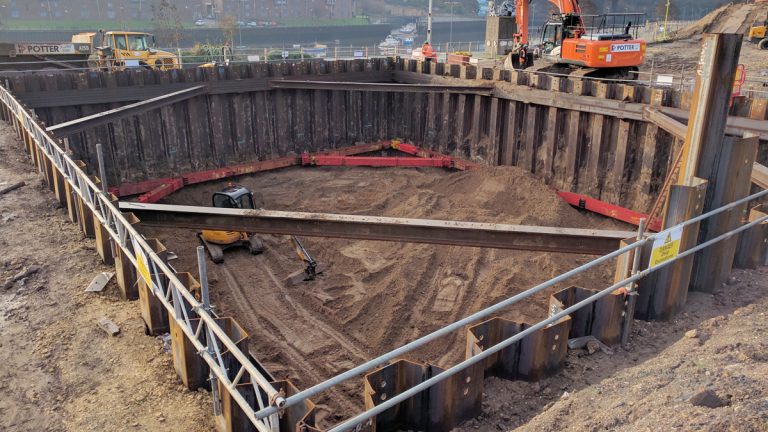
Interlocking sheet piled cofferdam for construction of the storage tank at St Peter’s, Sunderland – Courtesy of ESH-MWH
Summary
The project delivers the regulatory requirements in a sustainable way by:
- Optimising operation of existing assets.
- Taking out surface water load on the combined sewer network.
- Using SuDS in conjunction with conventional drainage.
The solution improves performance of the sewer network by reducing pumping and treatment costs, reducing flood risk and increasing sewer capacity for future growth. The solution brings additional benefits to the catchment including:
- Roker Public Park, two schools and several public open spaces are benefitting from water features, planting and landscaping in return for space to store water.
- Rainwater planters within schools provide amenity benefit and an educational opportunity for involving school children.
- Water quality, amenity and biodiversity enhancements using appropriate planting within SuDS features.
- Education through local school workshops on the construction process and the water cycle.
Construction was completed within programme and delivered significant efficiencies to business budgets.







